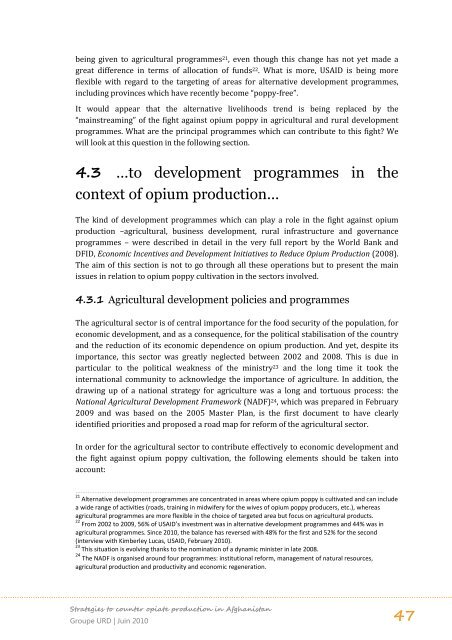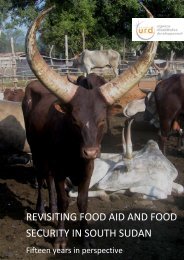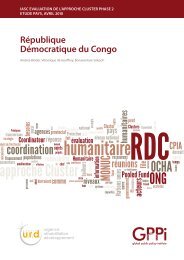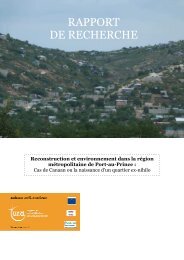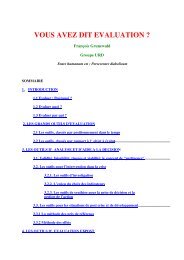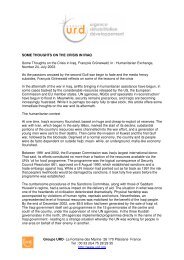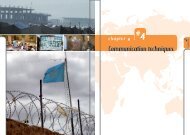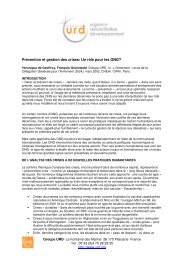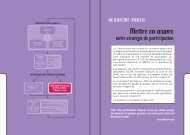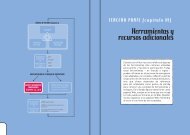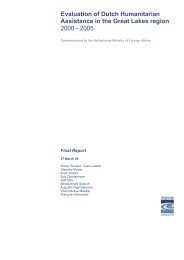strategies to counter opiate in Afghanistan - Groupe URD
strategies to counter opiate in Afghanistan - Groupe URD
strategies to counter opiate in Afghanistan - Groupe URD
Create successful ePaper yourself
Turn your PDF publications into a flip-book with our unique Google optimized e-Paper software.
e<strong>in</strong>g given <strong>to</strong> agricultural programmes 21 , even though this change has not yet made a<br />
great difference <strong>in</strong> terms of allocation of funds 22 . What is more, USAID is be<strong>in</strong>g more<br />
flexible with regard <strong>to</strong> the target<strong>in</strong>g of areas for alternative development programmes,<br />
<strong>in</strong>clud<strong>in</strong>g prov<strong>in</strong>ces which have recently become “poppy-free”.<br />
It would appear that the alternative livelihoods trend is be<strong>in</strong>g replaced by the<br />
“ma<strong>in</strong>stream<strong>in</strong>g” of the fight aga<strong>in</strong>st opium poppy <strong>in</strong> agricultural and rural development<br />
programmes. What are the pr<strong>in</strong>cipal programmes which can contribute <strong>to</strong> this fight We<br />
will look at this question <strong>in</strong> the follow<strong>in</strong>g section.<br />
4.3 …<strong>to</strong> development programmes <strong>in</strong> the<br />
context of opium production…<br />
The k<strong>in</strong>d of development programmes which can play a role <strong>in</strong> the fight aga<strong>in</strong>st opium<br />
production –agricultural, bus<strong>in</strong>ess development, rural <strong>in</strong>frastructure and governance<br />
programmes – were described <strong>in</strong> detail <strong>in</strong> the very full report by the World Bank and<br />
DFID, Economic Incentives and Development Initiatives <strong>to</strong> Reduce Opium Production (2008).<br />
The aim of this section is not <strong>to</strong> go through all these operations but <strong>to</strong> present the ma<strong>in</strong><br />
issues <strong>in</strong> relation <strong>to</strong> opium poppy cultivation <strong>in</strong> the sec<strong>to</strong>rs <strong>in</strong>volved.<br />
4.3.1 Agricultural development policies and programmes<br />
The agricultural sec<strong>to</strong>r is of central importance for the food security of the population, for<br />
economic development, and as a consequence, for the political stabilisation of the country<br />
and the reduction of its economic dependence on opium production. And yet, despite its<br />
importance, this sec<strong>to</strong>r was greatly neglected between 2002 and 2008. This is due <strong>in</strong><br />
particular <strong>to</strong> the political weakness of the m<strong>in</strong>istry 23 and the long time it <strong>to</strong>ok the<br />
<strong>in</strong>ternational community <strong>to</strong> acknowledge the importance of agriculture. In addition, the<br />
draw<strong>in</strong>g up of a national strategy for agriculture was a long and <strong>to</strong>rtuous process: the<br />
National Agricultural Development Framework (NADF) 24 , which was prepared <strong>in</strong> February<br />
2009 and was based on the 2005 Master Plan, is the first document <strong>to</strong> have clearly<br />
identified priorities and proposed a road map for reform of the agricultural sec<strong>to</strong>r.<br />
In order for the agricultural sec<strong>to</strong>r <strong>to</strong> contribute effectively <strong>to</strong> economic development and<br />
the fight aga<strong>in</strong>st opium poppy cultivation, the follow<strong>in</strong>g elements should be taken <strong>in</strong><strong>to</strong><br />
account:<br />
………………………………………………………………………………………………………………………………………………………………<br />
21 Alternative development programmes are concentrated <strong>in</strong> areas where opium poppy is cultivated and can <strong>in</strong>clude<br />
a wide range of activities (roads, tra<strong>in</strong><strong>in</strong>g <strong>in</strong> midwifery for the wives of opium poppy producers, etc.), whereas<br />
agricultural programmes are more flexible <strong>in</strong> the choice of targeted area but focus on agricultural products.<br />
22 From 2002 <strong>to</strong> 2009, 56% of USAID’s <strong>in</strong>vestment was <strong>in</strong> alternative development programmes and 44% was <strong>in</strong><br />
agricultural programmes. S<strong>in</strong>ce 2010, the balance has reversed with 48% for the first and 52% for the second<br />
(<strong>in</strong>terview with Kimberley Lucas, USAID, February 2010).<br />
23 This situation is evolv<strong>in</strong>g thanks <strong>to</strong> the nom<strong>in</strong>ation of a dynamic m<strong>in</strong>ister <strong>in</strong> late 2008.<br />
24 The NADF is organised around four programmes: <strong>in</strong>stitutional reform, management of natural resources,<br />
agricultural production and productivity and economic regeneration.<br />
Strategies <strong>to</strong> <strong>counter</strong> <strong>opiate</strong> production <strong>in</strong> <strong>Afghanistan</strong><br />
<strong>Groupe</strong> <strong>URD</strong> | Ju<strong>in</strong> 2010<br />
47


